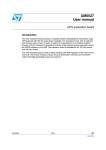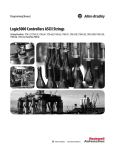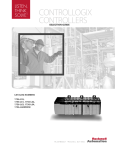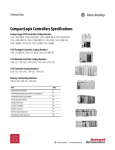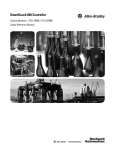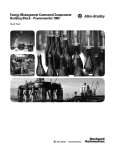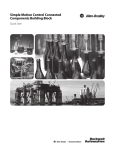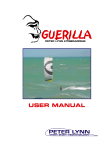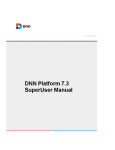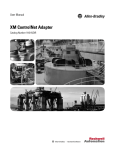Download Logix5000 Controllers ASCII Strings Programming Manual
Transcript
Logix5000 Controllers ASCII Strings
Programming Manual
Catalog Numbers 1756-L1, 1756L55, 1756-L61, 1756-L62, 1756-L63,
1769-L31, 1769-L32C, 1769-L32E, 1769L35CR, 1769-L35E, 1789-L60, 1794-L34,
PowerFlex 700S/SE
Important User Information
Solid state equipment has operational characteristics differing from those of electromechanical equipment. Safety Guidelines for the
Application, Installation and Maintenance of Solid State Controls (publication SGI-1.1 available from your local Rockwell Automation sales
office or online at http://literature.rockwellautomation.com) describes some important differences between solid state equipment and hardwired electromechanical devices. Because of this difference, and also because of the wide variety of uses for solid state equipment, all
persons responsible for applying this equipment must satisfy themselves that each intended application of this equipment is acceptable.
In no event will Rockwell Automation, Inc. be responsible or liable for indirect or consequential damages resulting from the use or
application of this equipment.
The examples and diagrams in this manual are included solely for illustrative purposes. Because of the many variables and requirements
associated with any particular installation, Rockwell Automation, Inc. cannot assume responsibility or liability for actual use based on the
examples and diagrams.
No patent liability is assumed by Rockwell Automation, Inc. with respect to use of information, circuits, equipment, or software described in
this manual.
Reproduction of the contents of this manual, in whole or in part, without written permission of Rockwell Automation, Inc., is prohibited.
Throughout this manual, when necessary, we use notes to make you aware of safety considerations.
WARNING
IMPORTANT
ATTENTION
Identifies information about practices or circumstances that can cause an explosion in a
hazardous environment, which may lead to personal injury or death, property damage, or
economic loss.
Identifies information that is critical for successful application and understanding of the product.
Identifies information about practices or circumstances that can lead to personal injury or death,
property damage, or economic loss. Attentions help you identify a hazard, avoid a hazard, and
recognize the consequence
SHOCK HAZARD
Labels may be on or inside the equipment, for example, a drive or motor, to alert people that
dangerous voltage may be present.
BURN HAZARD
Labels may be on or inside the equipment, for example, a drive or motor, to alert people that
surfaces may reach dangerous temperatures.
Allen-Bradley, Rockwell Automation, and TechConnect are trademarks of Rockwell Automation, Inc.
Trademarks not belonging to Rockwell Automation are property of their respective companies.
Table of Contents
Preface
Purpose of this Manual . . . . . . . . . . . . . . . . . . . . . . . . . . . . . . . . . . . . . . 5
How to Use this Manual . . . . . . . . . . . . . . . . . . . . . . . . . . . . . . . . . . . . . 5
Chapter 1
Communicating with an ASCII
Device
Introduction . . . . . . . . . . . . . . . . . . . . . . . . . . . . . . . . . . . . . . . . . . . . . . . 7
Connect the ASCII Device . . . . . . . . . . . . . . . . . . . . . . . . . . . . . . . . . . . 8
Configure the Serial Port . . . . . . . . . . . . . . . . . . . . . . . . . . . . . . . . . . . . . 9
Configure the User Protocol . . . . . . . . . . . . . . . . . . . . . . . . . . . . . . . . . 10
Create String Data Types . . . . . . . . . . . . . . . . . . . . . . . . . . . . . . . . . . . . 11
Read Characters from the Device . . . . . . . . . . . . . . . . . . . . . . . . . . . . . 12
Send Characters to the Device. . . . . . . . . . . . . . . . . . . . . . . . . . . . . . . . 15
Enter ASCII Characters . . . . . . . . . . . . . . . . . . . . . . . . . . . . . . . . . . . . . 17
Chapter 2
Processing ASCII Characters
3Publication 1756-PM013B-EN-P - July 2008
Introduction . . . . . . . . . . . . . . . . . . . . . . . . . . . . . . . . . . . . . . . . . . . . . . 19
Extract a Part of a Bar Code . . . . . . . . . . . . . . . . . . . . . . . . . . . . . . . . . 19
Look Up a Bar Code . . . . . . . . . . . . . . . . . . . . . . . . . . . . . . . . . . . . . . . 20
Create the PRODUCT_INFO Data Type . . . . . . . . . . . . . . . . . . . 21
Search for the Characters . . . . . . . . . . . . . . . . . . . . . . . . . . . . . . . . 21
Identify the Lane Number. . . . . . . . . . . . . . . . . . . . . . . . . . . . . . . . 22
Reject Bad Characters . . . . . . . . . . . . . . . . . . . . . . . . . . . . . . . . . . . 22
Enter the Product IDs and Lane Numbers . . . . . . . . . . . . . . . . . . 23
Check the Bar Code Characters. . . . . . . . . . . . . . . . . . . . . . . . . . . . . . . 23
Convert a Value . . . . . . . . . . . . . . . . . . . . . . . . . . . . . . . . . . . . . . . . . . . 24
Decode an ASCII Message . . . . . . . . . . . . . . . . . . . . . . . . . . . . . . . . . . 25
Build a String . . . . . . . . . . . . . . . . . . . . . . . . . . . . . . . . . . . . . . . . . . . . . 26
ASCII Character Codes . . . . . . . . . . . . . . . . . . . . . . . . . . . . . . . . . . 29
3
Table of Contents
4
Publication 1756-PM013B-EN-P - July 2008
Preface
Purpose of this Manual
This manual shows how to manipulate ASCII strings in Logix5000 controllers.
This manual is one of a set of related manuals that show common procedures
for programming and operating Logix5000 controllers. For a complete list of
common procedures manuals, see the Logix 5000 Controllers Common
Procedures Programming Manual, publication 1756-PM001.
The term Logix5000 controller refers to any controller that is based on the
Logix5000 operating system, such as:
· CompactLogix controllers
· ControlLogix controllers
· DriveLogix controllers
· FlexLogix controllers
· SoftLogix5800 controllers
How to Use this Manual
Some text is formatted differently from the rest of the text.
Text that is
Identifies
Italic
the actual name of an item that you Right-click User-Defined …
see on your screen or in an example
Right-click the item that is named
User-Defined.
courier
information that you must supply
based on your application (a
variable)
Right-click
name_of_program …
You must identify the specific program in
your application. Typically, it is a name or
variable that you have defined.
Press [Enter].
Press the Enter key.
enclosed in brackets a keyboard key
5Publication 1756-PM013B-EN-P - July 2008
For example
Means
5
Notes:
6
Publication 1756-PM013B-EN-P - July 2008
Chapter
1
Communicating with an ASCII Device
You can exchange ASCII data with a device through the serial port of the
controller. For example, you can use the serial port to:
· read ASCII characters from a weigh scale module or bar code reader.
· send and receive messages from an ASCII triggered device, such as a
MessageView terminal.
Introduction
Connection from the serial port of the controller to the ASCII device
42237
In addition to the controller serial port, firmware revision 3.1 and greater of
the 1756-EWEB EtherNet/IP Web Server module supports a socket interface
that lets Logix5000 controllers exchange ASCII data using TCP or UDP
socket services. See the EtherNet/IP Web Server User Manual, publication
ENET-UM0527, revision C or later.
7Publication 1756-PM013B-EN-P - July 2008
7
Chapter 1
Communicating with an ASCII Device
Connect the ASCII Device
1. On the serial port of the ASCII device, determine which pins send
signals and which pins receive signals.
2. Connect sending pins to corresponding receiving pins and attach
jumpers.
If the communications
Then wire the connectors
Handshake
ASCII Device
Controller
1 CD
1 CD
2 RDX
2 RDX
3 TXD
3 TXD
4 DTR
4 DTR
COMMON
COMMON
6 DSR
6 DSR
7 RTS
7 RTS
8 CTS
8 CTS
9
9
42231
Do not handshake
ASCII Device
Controller
1 CD
1 CD
2 RDX
2 RDX
3 TXD
3 TXD
4 DTR
4 DTR
COMMON
COMMON
6 DSR
6 DSR
7 RTS
7 RTS
8 CTS
8 CTS
9
9
42232
3. Attach the cable shield to both connectors.
4. Connect the cable to the controller and the ASCII device.
8
Publication 1756-PM013B-EN-P - July 2008
Communicating with an ASCII Device
Configure the Serial Port
Chapter 1
1. On the Online toolbar in the controller project, click the controller
button.
2. Select the Serial Port tab.
3. Select User mode and enter the configuration settings for the serial port.
· Select the baud rate, data bits, parity, and stop bits.
· Select the Control Line option:
If
And
And this is the
You are not using a
modem
You are using a
modem
Select
Then
No Handshaking
Both modems in a
point-to-point link are
full-duplex
Master modem is
full-duplex while slave
modem is half-duplex
Full Duplex
master controller.
Full Duplex
slave controller
Half Duplex
Check the Continuous Carrier
check box.
Half Duplex
Clear the Continuous Carrier
check box (default).
All modems in the system
are half-duplex
· For RTS Send Delay, enter the delay (in 20 ms units) between the time
the RTS signal turns on (high) and the time that data is sent. For
example, a value of 4 produces an 80 ms delay.
· For RTS Off Delay, enter the delay (in 20 ms units) between the time the
last character is sent and the time that the RTS signal turns off (low).
4. Click Apply.
Publication 1756-PM013B-EN-P - July 2008
9
Chapter 1
Communicating with an ASCII Device
Configure the User Protocol
1. Select the User Protocol tab.
42252
· Enter a buffer size that is greater than or equal to the greatest number of
characters in a transmission. (Twice the number of characters is a good
guideline.)
· For ABL or ARL instructions, enter termination characters to mark the
end of the data. For ASCII codes, see the back cover of this manual.
If the device
sends
One termination
character
Then
Notes
· In the Termination Character 1 text
box, type the hexadecimal ASCII
code for the first character.
· In the Termination Character 2 text
box, type $FF.
Two termination
characters
For printable
characters, such
as 1 or A, type the
character.
In the Termination Character 1 and 2
text boxes, type the hexadecimal ASCII
code for each character.
· For AWA instruction, enter append characters. For ASCII codes, see the
back cover of this manual.
To append
One character
Then
Notes
· In the Append Character 1 text box, For printable
characters, such
type the hexadecimal ASCII code
as 1 or A, type the
for the first character.
· In the Append Character 2 text box, character.
type $FF.
Two characters
10
In the Append Character 1 and 2 text
boxes, type the hexadecimal ASCII
code for each character.
Publication 1756-PM013B-EN-P - July 2008
Communicating with an ASCII Device
Chapter 1
· If the ASCII device is configured for XON/XOFF flow control, select
the XON/XOFF check box.
· If the ASCII device is a CRT or is pre-configured for half duplex
transmission, select the Echo Mode check box.
· Select the Delete Mode:
If the ASCII device is
Select
CRT
CRT
Notes
· The DEL character ($7F) and the character that precedes the DEL
character are not sent to the destination.
· If echo mode is selected and an ASCII instruction reads the DEL
character, the echo returns three characters: BACKSPACE SPACE
BACKSPACE ( $08 $20 $08).
Printer
Printer
· The DEL character ($7F) and the character that precedes the DEL
character are not sent to the destination.
· If echo mode is selected and an ASCII instruction reads the DEL
character, the echo returns two characters: / ($2F) followed by the
character that was deleted.
None of the above
Ignore
The DEL character ($7F) is treated as any other character.
2. Click OK.
Create String Data Types
Store ASCII characters in tags that use a string data type.
42811
42812
You can use the default STRING data type.
It stores up to 82 characters.
Publication 1756-PM013B-EN-P - July 2008
or
You can create a new string data type to store the
number of characters that you define.
11
Chapter 1
Communicating with an ASCII Device
IMPORTANT
Use caution when you create a new string data type. If you later decide to change
the size of the string data type, you may lose data in any tags that currently use
that data type.
If you
Make a string data type smaller
Then
· The data is truncated.
· The LEN is unchanged.
Make a string data type larger
The data and LEN is reset to zero.
1. In the controller organizer, right-click Strings and choose New String
Type…
2. Type a name for the data type.
3. Type the maximum number characters that this string data type will
store.
4. Click OK.
42233
Read Characters from the
Device
As a general rule, before you read the buffer use an ACB or ABL instruction to
verify that the buffer contains the required characters.
· An ARD or ARL instruction continues to read the buffer until the
instruction reads the required characters.
· While an ARD or ARL instruction is reading the buffer, no other ASCII
Serial Port instructions, except the ACL, can execute.
· Verifying that the buffer contains the required characters prevents the
ARD or ARL from holding up the execution of other ASCII Serial Port
instructions while the input device sends its data.
For additional information on ASCII Serial Port instructions, see Logix5000
Controllers General Instruction Set Reference Manual, publication
1756-RM003.
For example, the device sends s fixed number of characters, such as a bar code
reader:
12
Publication 1756-PM013B-EN-P - July 2008
Communicating with an ASCII Device
EXAMPLE
Chapter 1
A bar code reader sends bar codes to the serial port (channel 0) of the controller. Each bar code
contains 24 characters. To determine when the controller receives a bar code, the ACB instruction
continuously counts the characters in the buffer.
bar_code_count.EN
/
ACB
ASCII Chars in Buffer
Channel
0
SerialPort Controlbar_code_count
Character Count
0
EN
DN
ER
When the buffer contains at least 24 characters, the controller has received a bar code. The ARD
instruction moves the bar code to the bag_bar_code tag.
GEQ
Grtr Than or Eql (A>=B)
Source A bar_code_count.pos
0
Source B
24
ARD
ASCII Read
Channel
Destination
0
bag_bar_code
''
SerialPort Controlbar_code_read
String Length
24
Characters Read
0
EN
DN
ER
42227
Publication 1756-PM013B-EN-P - July 2008
13
Chapter 1
Communicating with an ASCII Device
For example, the device sends a variable number of characters, such as a
message or display terminal.
EXAMPLE
Continuously test the buffer for a message.
· Since each message ends in a carriage return ($0D), the carriage return is configured as the
termination character in the Controller Properties dialog box, User Protocol tab.
· When the ABL finds a carriage return, its sets the FD bit.
MV_line.EN
/
ABL
ASCII Test For Buffer Line
Channel
0
SerialPort Control
MV_line
Character Count
0
EN
DN
ER
When the ABL instruction finds the carriage return (MV_line.FD is set), the controller removes the
characters from the buffer, up to and including the carriage return, and places them in the MV_msg tag.
MV_line.FD
ARL
ASCII Read Line
Channel
Destination
SerialPort Control
String Length
Characters Read
EN
0
MV_msg
''
MV_read
12
0
DN
ER
42226
14
Publication 1756-PM013B-EN-P - July 2008
Communicating with an ASCII Device
Send Characters to the
Device
Chapter 1
When you send characters to the device, you need to determine whether you
will always send the same number of characters each time and whether you
want to append terminations characters to the data.
For example, you always send the same number of characters and want to
automatically append one or two characters to the end of the data.
EXAMPLE
When the temperature exceeds the high limit (temp_high is on), the AWA instruction sends five
characters from the string[1] tag to a MessageView terminal.
· The $14 counts as one character. It is the hex code for the Ctrl-T character.
· The instruction also sends (appends) the characters defined in the user protocol. In this
example, the AWA instruction sends a carriage return ($0D), which marks the end of the
message.
temp_high
AWA
ASCII Write Append
Channel
Source
SerialPort Control
String Length
Characters Sent
EN
0
string[1]
'$1425\1'
temp_high_write
5
6
DN
ER
42229
And then to always send the same number of characters:
EXAMPLE
When the temperature reaches the low limit (temp_low is on), the AWT instruction sends nine characters
from the string[2] tag to a MessageView terminal. (The $14 counts as one character. It is the hex code for
the Ctrl-T character.)
temp_low
AWT
ASCII Write
Channel
Source
SerialPort Control
String Length
Characters Sent
EN
0
string[2]
'$142224\01$r'
temp_low_write
9
9
DN
ER
42229
Publication 1756-PM013B-EN-P - July 2008
15
Chapter 1
Communicating with an ASCII Device
For example, you send a different number of characters each time and want to
automatically append one or two characters to the end of the data:
EXAMPLE
When alarm is on, the AWA instruction sends the characters in alarm_msg and appends a termination
character.
· Because the number of characters in alarm_msg varies, the rung first moves the length of
alarm_msg (alarm_msg.LEN) to the length of the AWA instruction (alarm_write.LEN).
· In alarm_msg, the $14 counts as one character. It is the hex code for the Ctrl-T character.
alarm
MOV
Move
Source alarm_msg.LEN
5
Dest
alarm_write.LEN
5
AWA
ASCII Write Append
Channel
Source
SerialPort Control
String Length
Characters Sent
EN
0
alarm_msg
'$1425\1'
alarm_write
5
6
DN
ER
42229
And then to send a different number of characters each time:
EXAMPLE
When MV_update is on, the AWT instruction sends the characters in MV_msg.
· Because the number of characters in MV_msg varies, the rung first moves the length of
MV_msg (MV_msg.LEN) to the length of the AWT instruction (MV_write.LEN).
· In MV_msg, the $16 counts as one character. It is the hex code for the Ctrl-V character.
MV_update
MOV
Move
Source MV_msg.LEN
10
Dest
MV_write.LEN
10
AWT
ASCII Write
Channel
Source
EN
0
MV_msg
'$161365\8\1$r'
SerialPort Control
MV_write
String Length
10
Characters Sent
10
DN
ER
42229
16
Publication 1756-PM013B-EN-P - July 2008
Communicating with an ASCII Device
Chapter 1
Enter ASCII Characters
IMPORTANT
This String Browser window shows the characters up to the
value of the LEN member of the string tag. The string tag may
contain additional data, which the String Browser window does
not show.
1. Double-click the value area of the Source.
42616
A text entry box appears:
Dollar sign ($24)
Single quote ($27)
Line feed ($0A)
New line ($0D$0A)
Form feed ($0C)
Carriage return ($0D)
Tab ($09)
42615
The number of characters that you see in the
window. This is the same as the LEN
member of the string tag.
The maximum number of characters that the
string tag can hold.
2. Enter the characters for the string.
3. Click OK.
Publication 1756-PM013B-EN-P - July 2008
17
Chapter 1
Communicating with an ASCII Device
Notes:
18
Publication 1756-PM013B-EN-P - July 2008
Chapter
2
Processing ASCII Characters
Introduction
You can process ASCII characters to:
· interpret a bar code and take action based on the bar code.
· use a weight from a weigh scale when the weight is sent as ASCII
characters.
· decode a message from an ASCII triggered device, such as an operator
terminal.
· build a string for an ASCII triggered device using variables from your
application.
Extract a Part of a Bar Code
For example, a bar code may contain information about a bag on a conveyor at
an airport. To check the flight number and destination of the bag, you extract
characters 10 - 18.
Airline
Bar code
N
W A
Character number
1
2
3
Origin
4
5
H
O
P
6
7
8
Flight #
5
9
0
5
Destination
8
A
M
S
Date
0
2
2
2
0
1
10 11 12 13 14 15 16 17 18 19 20 21 22 23 24
5
0
5
8
A
M
S
9 characters
EXAMPLE
In the baggage handling conveyor of an airport, each bag gets a bar code. Characters 10 - 18 of the
bar code are the flight number and destination airport of the bag. After the bar code is read
(bag_read.EM is on) the MID instruction copies the flight number and destination airport to the
bag_flt_and_dest tag.
42808
19Publication 1756-PM013B-EN-P - July 2008
19
Chapter 2
Processing ASCII Characters
For example, in a sorting operation, an array of a user-defined data type creates
a table that shows the lane number for each type of product. To determine
which lane to route a product, the controller searches the table for the product
ID (characters of the bar code that identify the product).
Look Up a Bar Code
Tag Name
Value
− sort_table
product_id
’GHI’
− sort_table[0]
+ sort_table[0].Product_ID
’ABC’
+ sort_table[0].Lane
1
− sort_table[1]
+ sort_table[1].Product_ID
’DEF’
+ sort_table[1].Lane
2
− sort_table[2]
+ sort_table[2].Product_ID
’GHI’
+ sort_table[2].Lane
lane
3
3
To look up a bar code:
· Create the PRODUCT_INFO Data Type.
· Search for the Characters.
· Identify the Lane Number.
· Reject Bad Characters.
· Enter the Product IDs and Lane Numbers.
TIP
To copy the above components from a sample project, open the
…\RSLogix 5000\Projects\Samples folder.
Open this project.
43039
20
Publication 1756-PM013B-EN-P - July 2008
Processing ASCII Characters
Chapter 2
Create the PRODUCT_INFO Data Type
To create a new data type:
Create this user-defined data type.
+ Controller Your_Project
Data Type: PRODUCT_INFO
+ Tasks
Name
PRODUCT_INFO
+ Motion Groups
Description
Identifies the destination for an item based on an ASCII string of
characters that identify the item
Trends
− Data Types
User-Defined
Members
Name
+ Product_ID
Lane
Data Type
Style
STRING
DINT
Description
ASCII characters that identify the item
Decimal
Destination for the item, based on its ID
Right-click and choose New Data
Type.
Search for the Characters
43038
The SIZE instruction:
· counts the number of elements in the sort_table array (type
PRODUCT_INFO). This array contains the product ID for each
item and the corresponding lane number for the item.
· counts the number of elements in Dimension 0 of the array. In this
case, that is the only dimension.
· sets the Length of the subsequent FSC instruction equal to the size
of the sort_table array.
The FSC instruction searches each Product_ID member in the sort_table
array until the instruction finds a match to the product_id tag.
· The sort_table_search tag controls the FSC instruction.
· Although the previous instruction sets the Length of this instruction,
you enter an initial value to verify the project.
· The product_id tag contains the bar code characters that you want to
find.
Publication 1756-PM013B-EN-P - July 2008
21
Chapter 2
Processing ASCII Characters
Identify the Lane Number
43038
When the FSC instruction finds the product ID within the sort_table array, the
instruction sets the FD bit. The POS member indicates the element number
within the sort_table array of the match. The corresponding LANE member
indicates the lane number of the match.
Based on the POS value, the MOV instruction moves the corresponding lane
number into the lane tag. The controller uses the value of this tag to route the
item.
After the MOV instruction sets the value of the lane tag, the RES instruction
resets the FSC instruction so it can search for the next product ID.
Reject Bad Characters
43038
If the FSC instruction does not find the product ID within the sort_table
array, the instruction sets the DN bit. The MOV instruction moves 999 into
the lane tag to notify the controller to reject or reroute the item.
After the MOV instruction sets the value of the lane tag, the RES instruction
resets the FSC instruction so it can search for the next product ID.
22
Publication 1756-PM013B-EN-P - July 2008
Processing ASCII Characters
Chapter 2
Enter the Product IDs and Lane Numbers
In the sort_table array, enter the ASCII characters to identify each item and the
corresponding lane number for the item.
Tag Name
Value
− sort_table
{…}
− sort_table[0]
{…}
+ sort_table[0].Product_ID
ASCII characters that identify the first item
+ sort_table[0].Lane
Lane number for the item
− sort_table[1]
Check the Bar Code
Characters
+ sort_table[1].Product_ID
ASCII characters that identify the next item
+ sort_table[1].Lane
Lane number for the item
Use a compare instruction (EQU, GEQ, GRT, LEQ, LES, NEQ) to check for
specific characters.
· The hexadecimal values of the characters determine if one string is less
than or greater than another string.
· When the two strings are sorted, as in a telephone directory, the order of
the strings determines which one is greater.
l
e
s
s
e
r
Publication 1756-PM013B-EN-P - July 2008
{…}
g
r
e
a
t
e
r
ASCII Characters
Hex Codes
1ab
$31$61$62
1b
$31$62
A
$41
AB
$41$42
B
$42
a
$61
ab
$61$62
AB < B
a>B
23
Chapter 2
Processing ASCII Characters
Use one of these compare instruction:
To see if the string is:
Enter this instruction:
Equal to specific characters
EQU
Not equal to specific characters
NEQ
Greater than specific characters
GRT
Equal to or greater than specific characters
GEQ
Less than specific characters
LES
Equal to or less than specific characters
LEQ
For example:
EXAMPLE
When bag_flt_and_dest is equal to gate[1], xfer[1] turns on. This routes the bag to the required
gate.
42808
Convert a Value
You can convert the ASCII representation of a value to an DINT or REAL
value that you can use in your application.
· The STOD and STOR instructions skip any initial control or
non-numeric characters (except the minus sign in front of a number).
· If the string contains multiple groups of numbers that are separated by
delimiters (e.g., / ), the STOD and STOR instructions convert only the
first group of numbers.
For example, to convert ASCII characters to a floating-point value:
EXAMPLE
After reading the weight from the scale (weight_read.EM is on), the STOR instruction converts the
numeric characters in weight_ascii to a REAL value and stores the result in weight.
42810
24
Publication 1756-PM013B-EN-P - July 2008
Processing ASCII Characters
Chapter 2
For example, to convert ASCII characters to an integer value:
EXAMPLE
When MV_read.EM is on, the STOD instruction converts the first set of numeric characters in
MV_msg to an integer value. The instruction skips the initial control character ($06) and stops at
the delimiter ( \ ).
42620
Decode an ASCII Message
You can extract and convert a value from an ASCII message that contains
multiple values. For example, a message may look like this:
First value
Second value
Third value
[Ctrl-F] message # \ F-key
\ F-key action [CR]
Control character
Delimiter
Delimiter
Termination character
Rung A: Find and
Convert a
Floating-Point Value
42810
Rung B: Find and
Convert an Integer
Value
42810
Publication 1756-PM013B-EN-P - July 2008
25
Chapter 2
Processing ASCII Characters
The FIND instruction locates characters within a string.
· The Source contains the string tag to search.
· The Result contains the location where the FIND instruction locates the
search value you specify.
The MID instruction identifies a group of characters within a string and places
them in their own string tag.
· The source is the same string tag as for the FIND instruction.
· The quantity values tells the MID instruction how many characters to
pull from the source.
· The start value is the same as the Result value from the FIND
instruction. This tells the MID instruction where to start pulling
characters from the Source.
· The Destination contains the characters you located.
Build a String
This example builds a string that contains two variables. For example, an
operator terminal may require a string that looks like this:
[Ctrl-F] message # \ address
[CR]
Control character
Termination character
Delimiter
· For more variables, use additional INSERT or CONCAT instructions.
· If you need to send a floating-point value, use a RTOS instruction in
place of the DTOS instruction.
· The final string does not include the termination character. When you
send the string, use an AWA instruction to automatically append the
termination character.
26
Publication 1756-PM013B-EN-P - July 2008
Processing ASCII Characters
EXAMPLE
Chapter 2
To trigger a message in a MessageView terminal, the controller sends the terminal a message in this
format: [Ctrl-T] message # \ address [CR]
When send_msg is on, the rung does this:
· The first DTOS instruction converts the message number to ASCII characters.
· The INSERT instruction inserts the message number (in ASCII) after the control character
[Ctrl-T]. (The hex code for Ctrl-T is $14.)
· The second DTOS instruction converts the node number of the terminal to ASCII characters.
· The CONCAT instruction puts the node number (in ASCII) after the backslash [ \ ] and stores
the final string in msg.
To send the message, an AWA instruction sends the msg tag and appends the carriage return [CR].
42813
Publication 1756-PM013B-EN-P - July 2008
27
Chapter 2
Processing ASCII Characters
Notes:
28
Publication 1756-PM013B-EN-P - July 2008
ASCII Character Codes
Hex
Character
Dec
Hex
Character
Dec
Hex
Character
Dec
Hex
[ctrl-@] NUL 0
$00
SPACE
32
$20
@
64
$40
‘
96
$60
[ctrl-A] SOH
1
$01
!
33
$21
A
65
$41
a
97
$61
[ctrl-B] STX
2
$02
“
34
$22
B
66
$42
b
98
$62
[ctrl-C] ETX
3
$03
#
35
$23
C
67
$43
c
99
$63
[ctrl-D] EOT
4
$04
$
36
$24
D
68
$44
d
100
$64
[ctrl-E] ENQ
5
$05
%
37
$25
E
69
$45
e
101
$65
[ctrl-F] ACK
6
$06
&
38
$26
F
70
$46
f
102
$66
[ctrl-G] BEL
7
$07
‘
39
$27
G
71
$47
g
103
$67
[ctrl-H] BS
8
$08
(
40
$28
H
72
$48
h
104
$68
[ctrl-I] HT
9
$09
)
41
$29
I
73
$49
i
105
$69
[ctrl-J] LF
10
$l ($0A)
*
42
$2A
J
74
$4A
j
106
$6A
[ctrl-K] VT
11
$0B
+
43
$2B
K
75
$4B
k
107
$6B
[ctrl-L] FF
12
$0C
,
44
$2C
L
76
$4C
l
108
$6C
[ctrl-M] CR
13
$r ($0D)
-
45
$2D
M
77
$4D
m
109
$6D
[ctrl-N] SO
14
$0E
.
46
$2E
N
78
$4E
n
110
$6E
[ctrl-O] SI
15
$0F
/
47
$2F
O
79
$4F
o
111
$6F
[ctrl-P] DLE
16
$10
0
48
$30
P
80
$50
p
112
$70
[ctrl-Q] DC1
17
$11
1
49
$31
Q
81
$51
q
113
$71
[ctrl-R] DC2
18
$12
2
50
$32
R
82
$52
r
114
$72
[ctrl-S] DC3
19
$13
3
51
$33
S
83
$53
s
115
$73
[ctrl-T] DC4
20
$14
4
52
$34
T
84
$54
t
116
$74
[ctrl-U] NAK
21
$15
5
53
$35
U
85
$55
u
117
$75
[ctrl-V] SYN
22
$16
6
54
$36
V
86
$56
v
118
$76
[ctrl-W] ETB
23
$17
7
55
$37
W
87
$57
w
119
$77
[ctrl-X] CAN
24
$18
8
56
$38
X
88
$58
x
120
$78
[ctrl-Y] EM
25
$19
9
57
$39
Y
89
$59
y
121
$79
[ctrl-Z] SUB
26
$1A
:
58
$3A
Z
90
$5A
z
122
$7A
ctrl-[ ESC
27
$1B
;
59
$3B
[
91
$5B
{
123
$7B
[ctrl-\] FS
28
$1C
<
60
$3C
\
92
$5C
|
124
$7C
ctrl-] GS
29
$1D
=
61
$3D
]
93
$5D
}
125
$7D
[ctrl-^] RS
30
$1E
>
62
$3E
^
94
$5E
~
126
$7E
[ctrl-_] US
31
$1F
?
63
$3F
_
95
$5F
DEL
127
$7F
Character
Dec
Rockwell Automation
Support
Rockwell Automation provides technical information on the Web to assist
you in using its products. At http://support.rockwellautomation.com, you can find
technical manuals, a knowledge base of FAQs, technical and application notes, sample
code and links to software service packs, and a MySupport feature that you can
customize to make the best use of these tools.
For an additional level of technical phone support for installation,
configuration, and troubleshooting, we offer TechConnect support programs.
For more information, contact your local distributor or Rockwell Automation
representative, or visit http://support.rockwellautomation.com.
Installation Assistance
If you experience a problem within the first 24 hours of installation, please
review the information that's contained in this manual. You can also contact
a special Customer Support number for initial help in getting your product up
and running.
United States
1.440.646.3434
Monday – Friday, 8am – 5pm EST
Outside United
States
Please contact your local Rockwell Automation representative for any
technical support issues.
New Product Satisfaction Return
Rockwell Automation tests all of its products to ensure that they are fully
operational when shipped from the manufacturing facility. However, if your
product is not functioning and needs to be returned, follow these
procedures.
United States
Contact your distributor. You must provide a Customer Support case
number (call the phone number above to obtain one) to your distributor
in order to complete the return process.
Outside United
States
Please contact your local Rockwell Automation representative for the
return procedure.
Publication 1756-PM013B-EN-P - July 2008 31
Supersedes Publication 1756-PM013A-EN-P - July 2007
Copyright © 2008 Rockwell Automation, Inc. All rights reserved. Printed in the U.S.A.
































